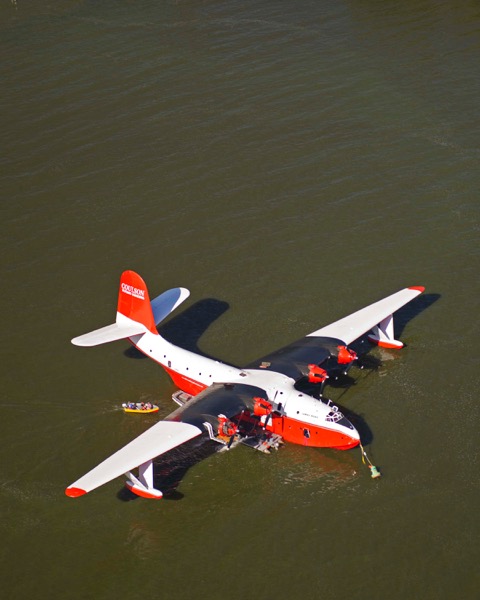 Scroll Down to see all of this week’s updates
Scroll Down to see all of this week’s updates
Mars Back in Canada For Repairs

Coulson Air Tankers flew its damaged Martin Mars from Oshkosh to Port Alberni on Tuesday and will do permanent hull repairs there.
The Mars was in Wisconsin as one of the star attractions at EAA AirVenture 2016. Local media said two softball-sized holes were punched in the sheet metal, likely when the fully-loaded aircraft scraped the bottom of the shallow lake during the landing.
The crew was able to lift off again to dump the 7,200 gallons of water on board to allow the aircraft to ride higher in the water when it landed again. The plane was taken to the EAA Seaplane base where local firefighters had pumps ready to eliminate the water inside the hull.
The aircraft was taking off from the seaplane base on Lake Winnebago for its afternoon performance at AirVenture on July 29 when warning lights illuminated on the control panel. The exact nature of the issue wasn’t released but it was said to be engine-related.
Procedure calls for an immediate precautionary landing and the extra weight of the water load was likely a factor in the underwater contact. Lake Winnebago is shallow throughout and its deepest point is just 21 feet.
F-35 ‘Combat-Ready’

The U.S. Air Force has declared the simplest version of the F-35 fighter “combat-ready” but there are a bunch of asterisks after that title.
The Air Force announcement comes somewhat suspiciously on the heels of the Canadian government’s apparently reluctant decision to include the F-35 in yet another procurement exercise for a replacement for the CF-18.
The aircraft cleared for operational use still isn’t fully functional. It’s data sharing system doesn’t work and the ejection seats are too dangerous for pilots weighing less than 140 pounds and risky for pilots weighing up to 160 pounds.
But they’re working on it and Gen. Herbert Carlisle told reporters at the Pentagon it’s good enough to fly for his purposes.
“We are not to full operational capability,” Carlisle, head of the U.S. air combat command, told the media. “We will evolve and continue to improve it just like we have every airplane in history.”
“I would deploy it to a combat zone for the missions that it is uniquely qualified to do and I would have all the confidence in the world that this airplane could conduct operations,” Carlisle said.
The announcement even surprised Lockheed Martin, the builder of the aircraft, but spokesman Jack Crisler grabbed the gift for what it was.
“It’s really demonstrating the maturity and effectiveness of the airplane,” he said. “The data is starting to pile up that this aircraft is very effective.”
RV Ski Set-Up Headed For Antarctica

The builder of the world’s only Rans RV-8 on wheel skis is helping an aviation explorer realize his dream.
Patrick Gilligan, VP of Operations for the Canadian Owners and Pilots Association, said he’ll volunteer his time to build a set for Michel Gordillo to allow him to fly over Antarctica this fall.
“This is Michel Gordillo’s third round-the-world flight and he will be studying the effects of black carbon particles that are affecting our atmosphere,” said Gilligan.
Gordillo will need to use snow runways in Antarctica and Gilligan’s system is the only tested option.
Gilligan has been flying with his since 2012 and reports they work well on unimproved fields, lakes and rivers.
Aviation Changes Pledged

A prominent contender for the leadership of the Progressive Conservative Party is pledging to overhaul Canada’s airline and airport system if he becomes prime minister.
Maxime Bernier said he’ll scrap foreign ownership requirements for domestic airlines, privatize airports and deregulate the industry to increase service and competition.
“Canada has a relatively strong air transportation industry and good infrastructure,” Bernier told a news conference.
“But like many other sectors of our economy, such as telecommunications and supply management in agriculture, it suffers from a lack of competition and from prices that are too high.”
Canadian airlines can only have 25 percent foreign ownership but proponents of new budget airlines have asked the government to lift that figure to 49 percent to help them attract investment.
Bernier said he’d allow airlines operating only in Canada to be 100 percent foreign owned but those flying outside the country would have to be majority owned by Canadians, likely because other countries have foreign ownership restrictions.
He said the restrictions prevent airlines from serving smaller centres.
“This is why I will eliminate the 25 per cent foreign ownership limits,” he said. “But why stop at 49 per cent? Australia and New Zealand allow 100 per cent foreign ownership for airlines that operate domestic services.”
Bernier said government-owned major airports are used as cash cows and contribute to high airfares in Canada. The airport authorities who run the airports do so as non-profit entities but the government charges a total of $5 billion a year in rent from 26 of those operators.
“These rents can represent up to 30 per cent of airport operating budgets, costs that are of course passed on to travellers.”
